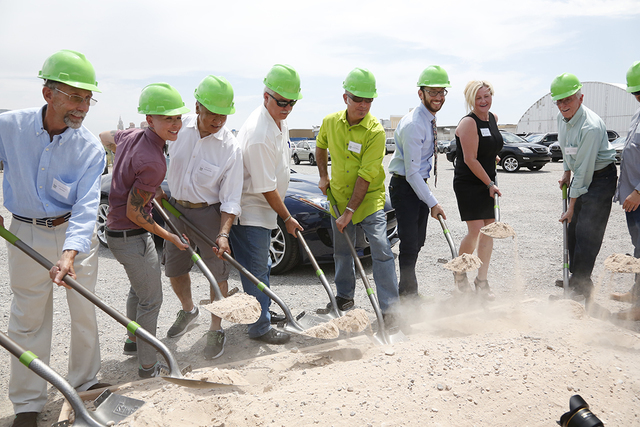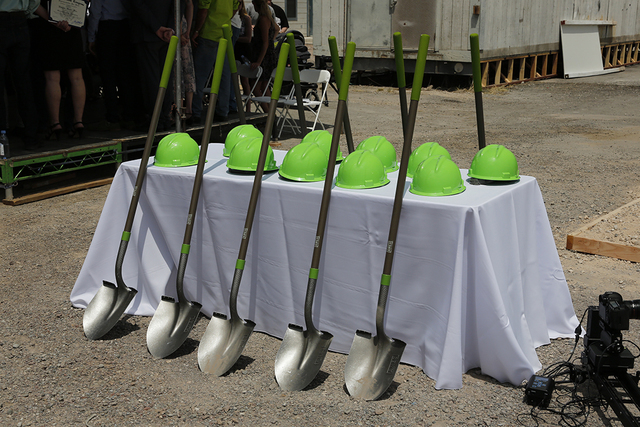Chefs launch Urban Seed to offer homegrown produce
















A revolution is underway in Las Vegas, and I’m not talking about the changes here at the Review-Journal with the arrival of my good friend John Katsilometes, who is about to take over the Page 3 Man About Town column.
This revolution involves chefs and restaurateurs of our destination city. Until now, farm-to-table freshness has really been farm-to-I-15-to-table as food is trucked in across the desert and flown in from around the world to meet the palate demands of our more than 40 million hungry visitors every year.
One of the most revolutionary homegrown urban farming concepts ever attempted here promises locally grown produce on hotel and restaurant tables by Christmas, and a contingent of chefs — Susan Feniger, Mary Sue Milliken, Michael Mina, Nicole Brisson, Geno Bernardo, Brian Howard, Sam Berkley, Rick Giffen, Jolene Mannina and Bryce Krausman — are serving as advisers for Urban Seed, which recently marked its groundbreaking.
They picked up shovels to turn the first earth at two empty lots on Wynn Road where two large modular greenhouses with hydroponic systems will be erected next month.
Planting begins at the end of October, and, because the new proprietary technology allows growth of 30 to 50 times the amount of produce than that of traditional farming without use of chemicals, the first crop will be harvested in December and delivered in time for Christmas Day.
Once these first two 6,400-square-foot facilities are up-and-running, the Urban Seed business plan calls for eight more on Wynn Road, followed by the rollout of another 90 greenhouses in Summerlin and Henderson starting next year. The goal with the 100 units is to become the premiere supplier of locally grown, low carbon impact fruits, vegetables and micro greens with unlimited growth.
I joined more than 250 food fans, chefs, restaurateurs and financial backers for the groundbreaking. “It’s taken a year to bring this vision to life,” said Rachel Wenman, VP of Urban Seed. “We have built a team of superheroes to help save the world. Las Vegas will have its own sustainable food system, so our battle cry is #VegasSavesTheWorld. We won’t be running short of food.”
The greenhouses incorporate vertical integration to reduce the carbon footprint and masterful use of much-reduced water resources, so our worrisome water situation won’t be of concern to the farmers led by senior grower Barry Hartsock with the blessings of UNLV and Dr. Robert Lang.
Susan (Border Grill at Mandalay Bay and Caesars Palace) told me: “People won’t believe we can grow in the desert here, just like they still don’t believe people actually live in Las Vegas. This just blows me away with the possibilities, especially the saving of water, 90 percent less water usage to grow the same amount of produce.
“Food in Las Vegas is a multibillion-dollar business, and all of our produce that we buy right now, 98 percent of it comes from California. We’re going to make a major dent in that. It’s also inspirational for the chefs, and, because there’s no more transportation through the desert, people will have a better taste treat and hopefully with price savings.
“I don’t know if California will be shaking in its boots losing the Las Vegas food market, but California and Florida, the two states that currently provide produce for Las Vegas, had better get in gear and do this, too. Urban Seed will be able to provide for our 45 million anticipated visitors requiring three meals a day out of these greenhouses.”
Urban Seed COO and Technology President Keith Bell added: “We’re looking to secure 23 acres of property in the Las Vegas Valley for our 100 greenhouses. We can grow here everything you would find in any other climate because we are actually controlling the climate inside the greenhouses.
“One greenhouse will produce 1.2 million plants per year. It’s ambitious, obviously, but we’ve been doing this for nearly five years of planning, developing and improving the technology, so it’s a very doable project. We’re going to have the next hundred up within two or three years.
“It would be a nice dream to not have to buy any food from California and Florida, but that would take a thousand greenhouses or more to meet that demand. But we’ll make a sizeable dent in that and more importantly get food from being picked on the farm to the table within three or four hours. It’s the freshest it could ever be.
“This is not just for restaurants and hotels. We’re partnered with charities, and we want to start farmer’s markets so we can get it to the people who can’t or don’t have to go to restaurants. The restaurant business get us off the ground, obviously, but eventually we’ll be into the grocery chain business.
“We can put this system anywhere in the world, for underprivileged nations, and the reason we call it Urban Seed is because we want to put it into urban desert, which doesn’t necessarily mean in a desert. It just means places where they haven’t grown food. … I can tell you our desert farming technology is advance, so I’m very confident about what we’ll have in Las Vegas.”
I’m putting my order in right now for Christmas dinner of Las Vegas-grown roast potatoes with Las Vegas-grown rosemary and Las Vegas-grown Brussels sprouts.












